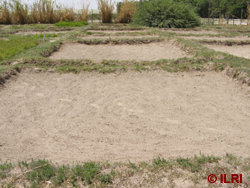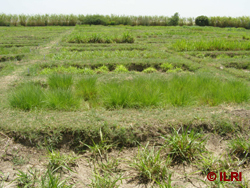Establishment in field banks of forage grass genetic resources
Contributors to this page: ILRI, Addis Ababa, Ethiopia (Jean Hanson); CIAT, Cali, Colombia (Rainer Schultze-Kraft); Bioversity International/ILRI, Addis Ababa, Ethiopia (Alexandra Jorge).
|
Contents: |
Preparation of planting material
Cleaning propagules/seeds in field banks
Field genebanks for grasses are usually planted using root splits or stem cuttings. For shy seeders, where only few seeds are available, they can also be established from seeds that are first germinated in the laboratory and transplanted to the field using similar sample processing procedures to those for seed establishment for forage seed genebanks.
Source of planting material in field banks
- Use seeds, stem cuttings or root splits, depending on the reproductive mechanism of the species (seeds or stem cuttings are preferred to root splits to avoid spread of pests in the soil around the roots). Wash root splits carefully to remove any soil before planting.
Using seeds
Seeds are used in the case of recalcitrant seeds that are difficult to keep for a long time in a seed genebank or for shy seeders where few seeds are produced.
Seeds should be germinated in petri dishes in an incubator. The conditions vary with species (see table for use in germination testing).
- As soon as the radicals start to emerge, plant the young seedlings individually in seedling trays or pots using sterilized compost or forest soil.
- Maintain the pots in a warm place and cover at night to retain moisture.
- Keep the pots away from direct sun but with good light intensity or in a greenhouse.
- Water carefully using a spray bottle so the pots remain moist but not wet.
- Once seedlings are strong and growing well, place the pots outside for one week for the seedlings to harden off, watering carefully.
- Label the plot with the accession number, planting date and plot number.
- Peg out the plots at the chosen row spacing and make holes at 50 cm along the row.
- Transplant the seedlings to the field, one seedling per hole taking care not to damage the roots when the seedlings are transferred from the pots, and water after transplanting.
See also germplasm testing section in the viability page in forage seed, for more details.
Using stem cuttings
- They should usually be first planted in pots in screen houses, tested for diseases and only the clean plants transplanted into field plots.
Using new root splits
- All the plants from the plots should be removed and vigorous and healthy root splits chosen from healthy plants to be replanted, usually into the same plot.
Pre-treatments
- Fumigation.
- Insecticide application.
- Others - as per forage seed genebanks.
Visual inspection of plant material
- Establish plants from vegetative cuttings in an isolated screened area and check carefully for pests and diseases before release to the field (vegetative materials have a high risk of transferring pests and diseases and visual inspection is important to ensure only clean material goes to the field).
- Insect damage - Check with the microscope that there are no insects hiding in the leaf whorls (insect eggs can be carried in the leaf whorls and hatch after transplanting to the field).
- Fungal damage - Observe the plants carefully for pathogenic fungi before transferring to the field. Incinerate any infected material (vegetative material can be a source of pathogenic fungi. Look for symptoms before the material is released).
- Mechanical damage.
- Empty seeds - Check that the seeds have caryopses by rubbing gently with sandpaper to remove the glumes (empty glumes are common in some grasses and caryopses should be removed for germination).
- Others - as per forage seed genebanks.
Disposal of contaminated material
- Incinerate or autoclave contaminated material (to avoid spreading diseases and pests).
Recording information during the preparation of planting material
The following information should be recorded for each processing step:
- Accession number (an ID number).
- Lot number (an ID number).
- Seed weight (weight of seeds for storage) or number of propagules.
- Reference to seed source (to trace the origin of the sample).
- Flags (Y/N) indicating completion of steps mentioned above (checking).
- Remarks.
Field preparation
- Select the environment and soil type best suited for the species (see table).
- Soil should be ploughed and disked, and weeds and grasses removed. The soil should be prepared by tillage to obtain a well prepared and level seed bed prior to planting.
Field planting
- Planting should be done at the start of the rainy season (to aid establishment).
- Aim for a final plant number of 30 in plots of 10 m2 for vegetatively propagated grasses.
- Plant in rows. Three rows of 5 m in length, each row 100 cm apart with within row spacing of 50 cm. Giving a density of 30 plants per plot is suitable for most grasses. See table, for more specific information about plot density of each species.
 |
 |
|
Empty plots waiting to be planted in the grass field genebank of Zwai, Ethiopia (photo: ILRI) |
Grass field genebank in Zwai, Ethiopia |
Frequency of new establishment
- It depends on the species and their growth rate, but it should generally be done every 3-5 years.
Field maintenance and management
|
|
Weed management
- Early growth can be slow and hand weeding four weeks after establishment is recommended.
- Eliminate plants growing off-row. Rogue out plants that are genuine mixtures.
Irrigation
- Irrigate the field after sowing and when needed subsequently. Do not allow the leaves to wilt at any stage. Ensure enough moisture in the soil at the time of flowering.
Fertilization
- It is recommended to apply phosphorous at planting using DAP at 100 kg per hectare. An additional application of 50-60 kg N per ha as a top dressing at early flowering stage will ensure good seed quality.
Common pest and diseases
- Forage grasses are susceptible to many fungal diseases and a few viruses and phytoplasma (see table, for the most frequently detected pests and diseases).
Pest and disease control
- Spray with fungicide to control mildew during the rainy season or when using irrigation and with insecticide at the first sign of insect damage. Pay particular attention to army worm and spray at the first infestation.
Renovation of field bank
- Regular maintenance of an existing field of grasses should be done by weeding, roughing and cutting the plants.
- Cutting should be regularly done twice or three times a year (to control pests and diseases, to promote young growth and flowering).
Harvesting seeds from grass field banks
Sometimes, there is a need to collect seeds from already established field genebanks in order to increase some seed stocks (many grasses have short-lived seeds or shy seeds – i.e. they do seed, but rarely or have a few caryopses). Seeds may be used to overcome difficulties in distributing vegetative material (due to pests and diseases, quarantine regulations or high volume /cost of transportation). In these cases, there is a need to isolate the seeds so they do not cross pollinate, and there are two main options to harvest seeds for dispatch:
Isolation
- Spatial isolation - generally 100 m between any related species.
- Temporal isolation – cut back all neighbouring related species (within 100 m) to prevent flowering, during flowering period.
Bagging and tagging
-
Bag the inflorescences (a bunch of them) to avoid contamination with foreign pollen during flowering time. Tag each stem for easier identification and remove the bags after flowering is completed to avoid condensation forming in the bags and causing rotting. Harvest the seeds when mature.
System for tracking material/inventory system in field banks
- Use a database for stock and location.
- Use pegs, tags or bar codes for labeling.
- Use impermeable ink and write clearly (databases are needed to keep track of information).
- Plots must be well labeled to avoid errors.
- Bar codes help avoid errors in recording.
Recording information during field bank establishment
The following information should be recorded during storage:
- Accession number (an ID number).
- Genus (genus name of the plant, entered in full).
- Species (species name of the plant, entered in full).
- Field genebank site name (a code to indicate the site of seed production).
- Plot number (the plot number at the production site).
- Plot size (plot size in square meters).
- Date of planting (the date that the planting was carried out).
- Type of planting [a code for the method used for planting (seed, cutting etc)].
- Number of plants (the total number of plants in a plot).
- Spacing within row [the space (in cm) between plants in a row].
- Spacing between rows [the space (in cm) between rows in a plot].
Comments
- No comments found





Leave your comments
Post comment as a guest